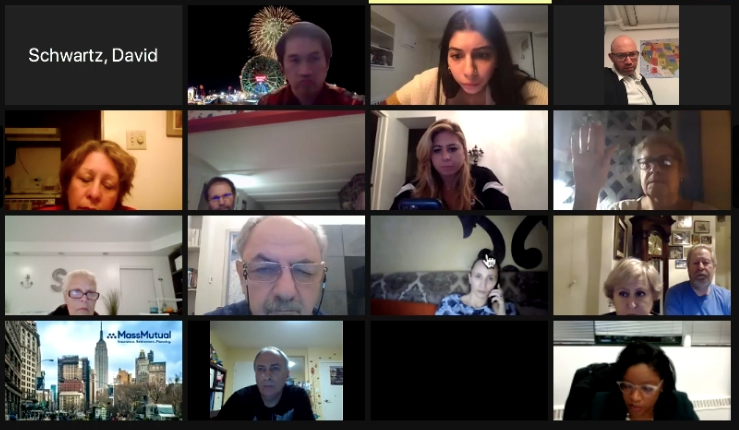At Community Board Meeting, Residents, Elected Officials and Candidates Slam Proposed Brighton Beach Shelter


Over 300 people joined a virtual community meeting Wednesday night to discuss a planned Brighton Beach shelter; seemingly all of them left unsatisfied.
At the two-hour virtual meeting, which was organized by Brooklyn Community Board 13, residents, elected officials and City Council candidates spoke in near-unanimous opposition to the plan to construct a 170-bed men’s shelter at 100 Neptune Avenue, raising concerns about everything from crime and beach access to environmental impacts to the city’s homeless policy itself.
“Opening new shelters is the wrong way to solve the homelessness crisis in New York City,” Council Member Chaim Deutsch, who represents the area, insisted at the meeting.
Deutsch had previously expressed concern about the proposed shelter’s operator, CORE, which came under fire at a Council hearing last year when the number of open violations at the organization’s 20 existing shelters topped 300. Deutsch said he spent four hours outside another CORE shelter earlier in the week, and spoke to a resident who told him he had been in the shelter system for over a year but had not received housing or job assistance.
“His issues exemplify the issues in the shelter system,” Deutsch said. “There is a lack of funding for services and a lack of resources, and that leads to people living in the shelter for months or years, instead of being rapidly housed in a permanent, supportive environment.”
Local Assembly Member Steven Cymbrowitz also criticized the proposal. While the city’s overall shelter footprint has shrunk, he said, the number of people in the shelter system has not dropped significantly since Mayor Bill de Blasio launched his “Turning the Tide” homelessness initiative three years ago. In October 2020, the number of single adults in the city’s shelters reached an all-time high: 21,210.
“I do not see why DHS and CORE are attempting an unsuccessful model at this site,” Cymbrowitz said.
But Matt Borden, an Assistant Deputy Commissioner at the city’s Department of Social Services who was on the call, said both shelters and permanent housing were necessary.
“If we had the ability today to snap our fingers and to turn every single temporary housing site that we have throughout the city into permanent housing,” he said, “tomorrow we would still have tons of families that would show up in need of housing because of evictions, because of fires, because of domestic violence.”
Several candidates running to replace term-limited Deutsch in the area’s City Council seat also voiced opposition. One, Amber Adler, echoed Cymbrowitz and Deutsch’s demand that the city create permanent supportive housing in place of temporary shelters. Another, Steven Saperstein, posted on Facebook that he “strongly opposed” the shelter and said “the Mayor’s awful agency management continues to fail us.”
A third candidate, Mariya Markh, circulated a petition asking the city to call off the development unless the city conducted an environmental study to examine the “probable environmental hazard” posed by the site’s decades long-use as an auto repair shop and location within the Coastal Zone Boundary delineated by the City’s Waterfront Revitalization Program (WRP).
Many community members, though, were more concerned about what they feared would take place beyond the shelter’s doors. Various attendees expressed fears about the site’s proximity to local schools and the impact the presence of shelter residents would have on public safety.
“Are [the residents] coming from other neighborhoods?” asked one resident, Lolita Divilova. “Because we have enough seasonal homelessness during the summer. And a lot of homeless people are on the beach, and the impact of an influx of another 170 single men who will definitely go to the beach will impact the economic development of our entertainment district, which is already impacted severely. There’s a lot of petty crimes, a lot of assaults right now.”
Divilova also said she worked near the Atlantic House Men’s Shelter in Crown Heights, where “loitering and littering” were frequent problems.
Borden said the Neptune Avenue shelter would be “nothing like that site at all,” because it would be smaller, and because, unlike the Crown Heights site, which is an “assessment facility where people are constantly coming and going,” residents at the Brighton Beach shelter would stay in place for longer periods of time.
Information sheets circulated by DSS shortly before the meeting say that CORE’s staffing plan involves employing “a minimum of six security guards per shift and one additional supervisor per shift,” as well as 35 security cameras throughout the property.
Gordon Jackson, CORE’s Vice President of Community Affairs, also pushed back on questions about his organization’s ability to safely and effectively manage its congregate shelter sites.
“Our staff are specially selected,” he said. “We train in everything from NARCAN to first aid to mental health awareness to conflict resolution to community engagement. From our security staff, to our operations staff, to our programs staff, whenever we go into a new community, we are sensitive to what is going on.”
Another CORE staffer, Keisha Phipps, said the organization’s high number of violations was in part due to their taking over in 2017 of existing, under-maintained cluster sites previously operated by other providors.
Borden insisted DSS was confident in CORE’s work, and also said the city would prepare an environmental assessment statement for the site to determine what remediation efforts would be necessary to make the site habitable.
Those answers were apparently unsatisfactory to the majority of attendees, some of whom cited the recent controversy over homeless housing at a hotel on the Upper West Side as justification for the opposition to the Brighton Beach shelter.
The Zoom meeting’s chatbox, meanwhile, was a fast-moving flood of frustration, profanity and anger.
“Place these people in low income and low cost areas,” wrote one attendee.
“This is not a family shelter – this is a single men shelter!!!” wrote another. “Single men!!! Roaming our streets.”
“How do we start a fund for a lawyer?” asked a third.
Only one attendee, a woman named Elena Landriscina, spoke in support of the planned shelter. She encouraged city officials to develop long-term housing solutions but also said “the availability of temporary housing is life-saving.”
“I believe that we as a community can support people who are in need,” Landriscina said. “And we can work together to resolve concerns and anxieties over placing a shelter here.”
Other information shared during the meeting:
- CORE said the renovated building would include 10,000 square feet of residential space, 1,700 square feet of dining space and 1,000 square feet of recreation space.
- DSS said the city would not pay for any necessary environmental remediation; CORE and the property owner would be responsible for those costs.
- The shelter would be classified as “Use Group 3” under the city’s zoning law and therefore would not require a rezoning.




